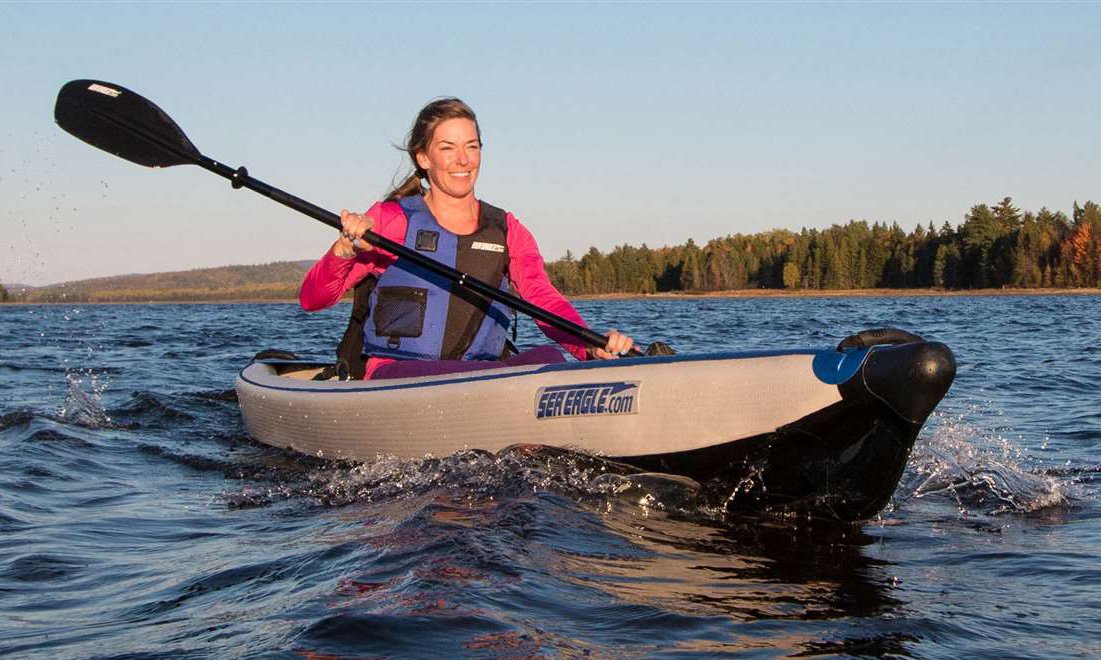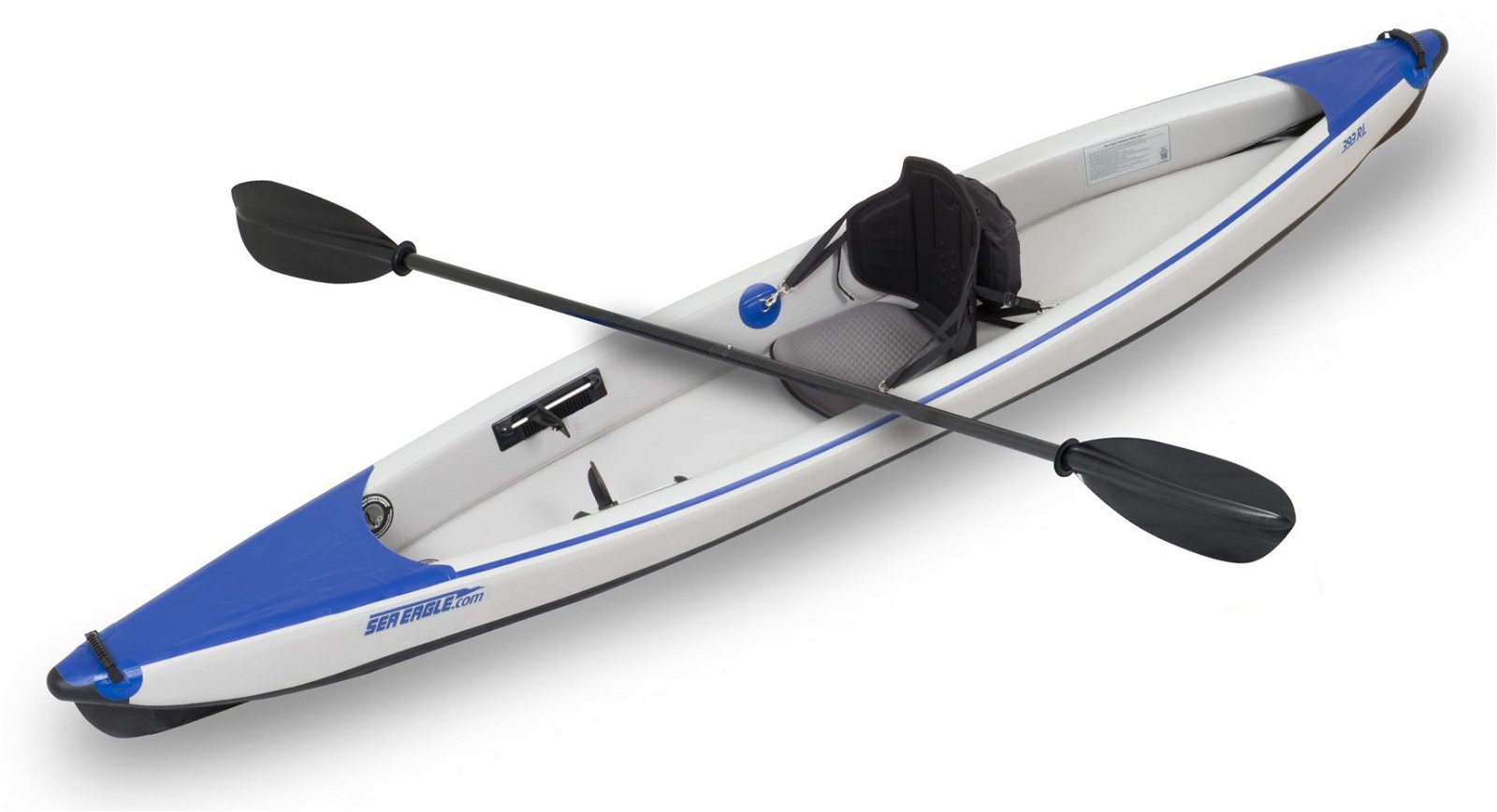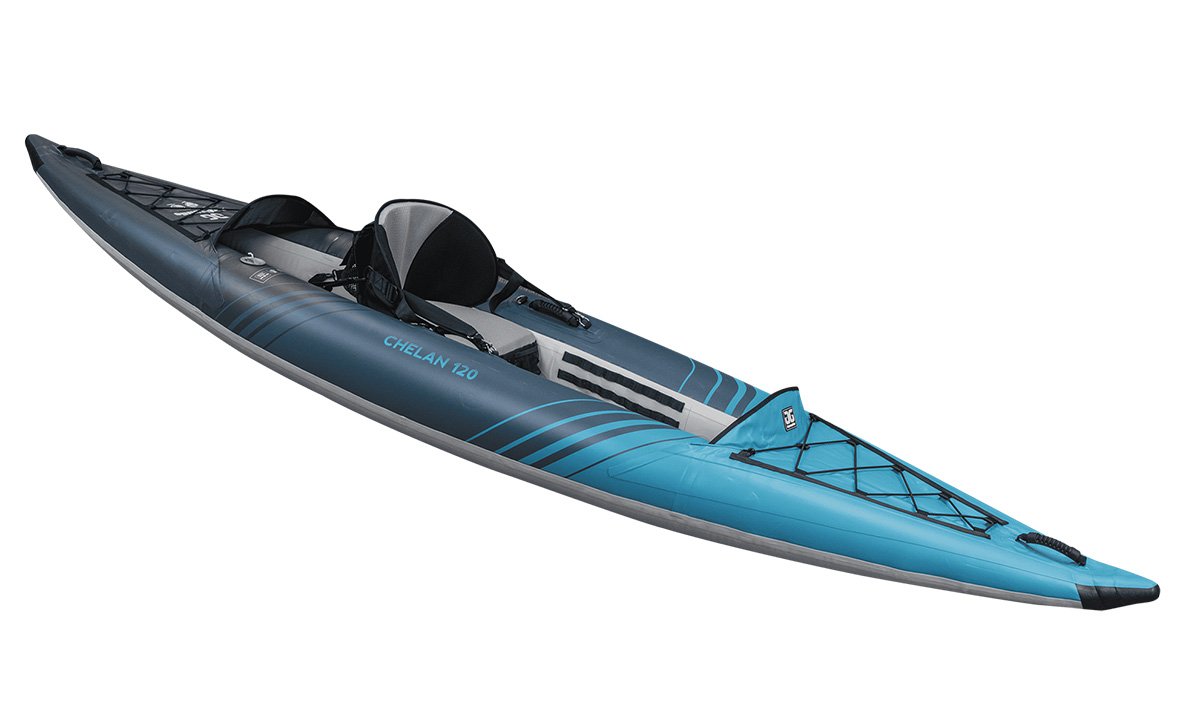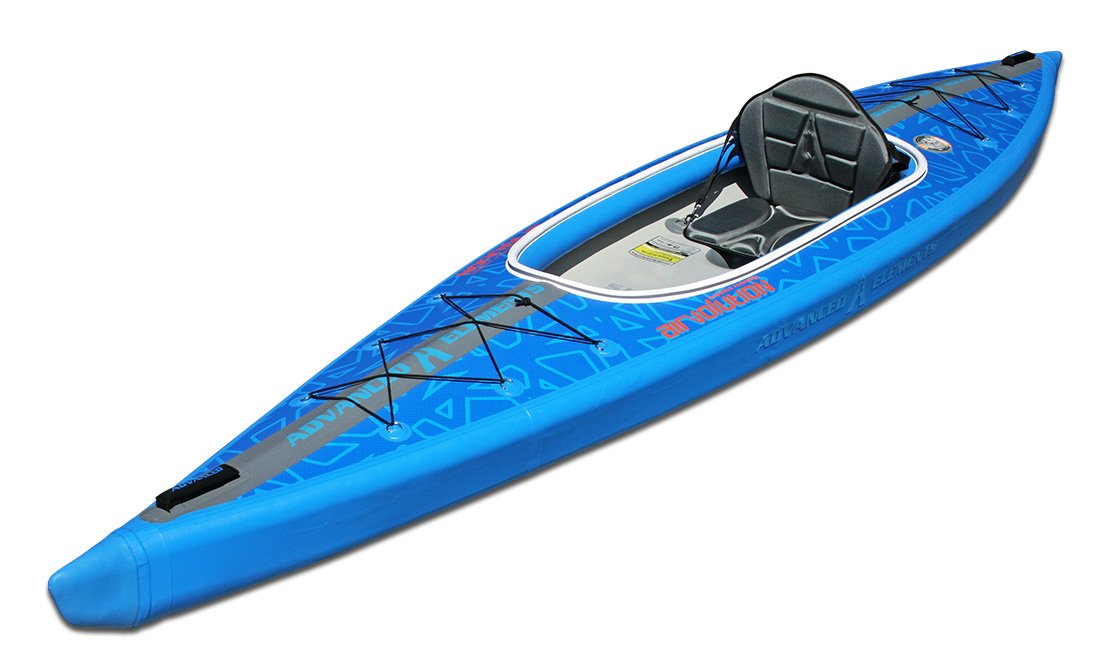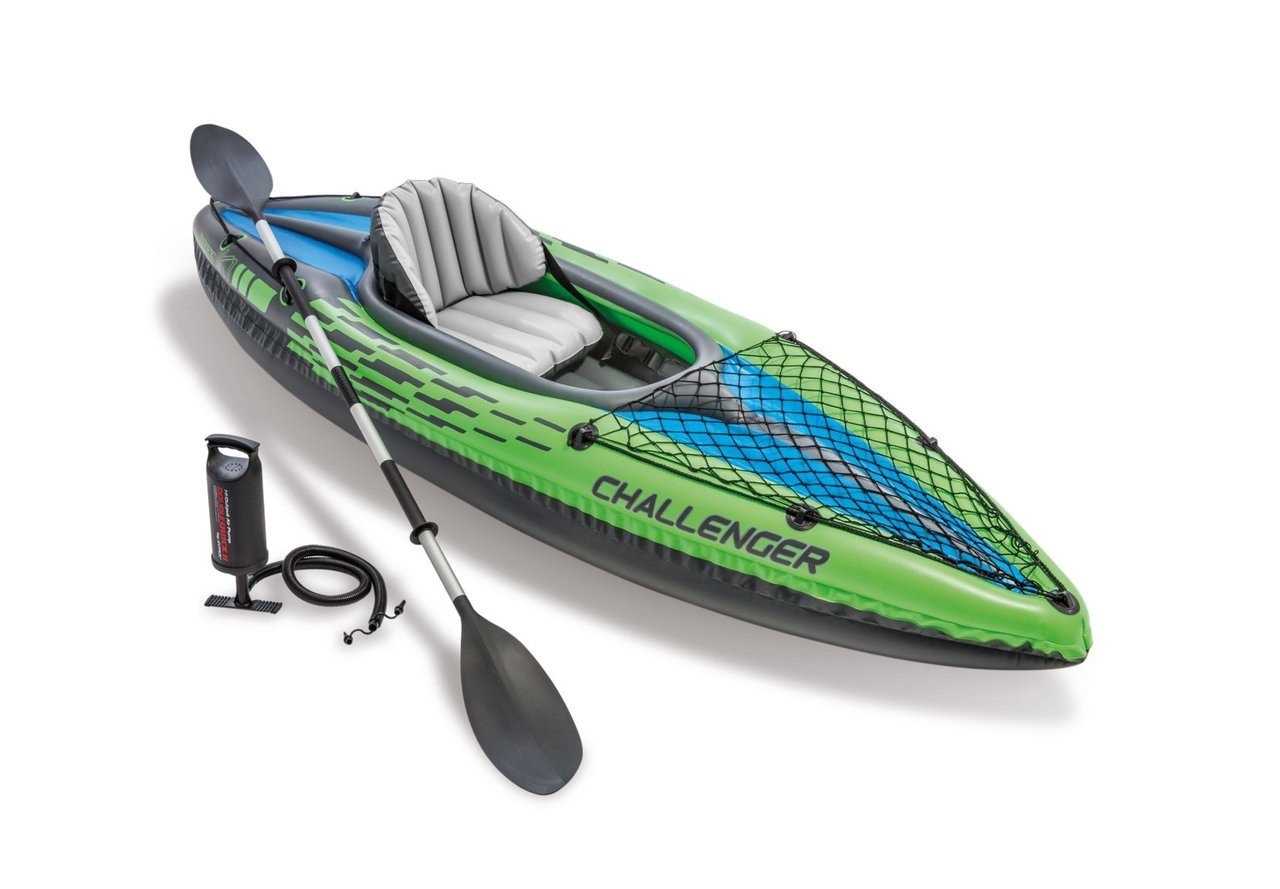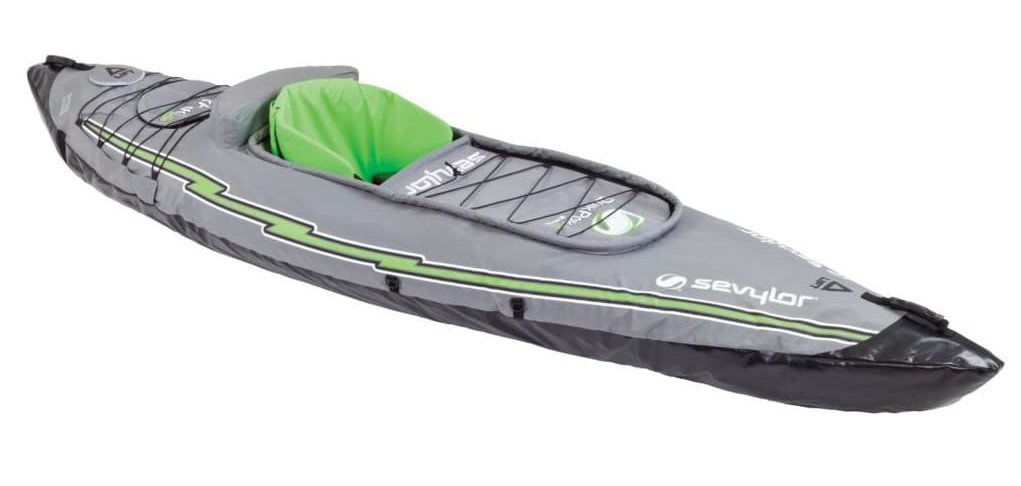Inflatable kayaks provide a practical, portable kayak option for beginner, advanced or intermediate paddlers wanting to take up this popular sport without having to find the storage space needed for a hardshell kayak.
But, with so many options available in today’s market, choosing the best inflatable kayak for one person can be a daunting task.
That’s why we’ve compiled and compared the most helpful hands-on reviews of the best solo inflatable kayaks on the market right now.
We’ve done this to bring you only the most useful information, cutting right to the chase, filtering out any fluff, and including only the top quality information from top quality reviewers that you can trust.
Kayak Scout’s extensive directory compares reviews from top kayaking experts and testers. So read on and you’re sure to find out which single person inflatable kayak is right for you – without having to scour hundreds of websites to do your research. We’ve already done that for you!
ALSO READ: Our roundup of all the best inflatable kayaks of 2024
Highest Rated 1 Person Inflatable Kayaks Compared
Reviews of the Best Inflatable Kayaks for 1 Person
Ready to dive into the nitty-gritty? Let’s take a closer look at the specs of our favorite kayaks and whether or not they might be a good fit for you.
1. Advanced Elements Expedition Elite (8.3 / 10)
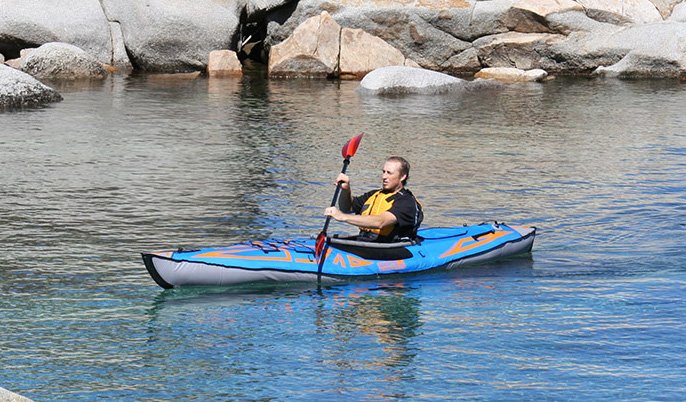
After thorough testing, we found the Advanced Elements Expedition Elite to be a high-performing inflatable kayak. It’s easy to get moving, thanks to its dual skegs, and it tracks almost like a hardshell kayak. We were impressed by its speed and stability, making it ideal for calm waters. The inflatable lumbar support and footrest added to our comfort, although the footrest was a bit contentious, causing some ankle fatigue for a few of us.
The Expedition Elite proved to be a tough kayak, resisting punctures and damage. We found it to be a stable boat, easy to balance on flat water, and manageable when we needed to power up our paddling. The onboard storage was sufficient for multiple legs of a journey, although the lack of basic kit, such as a pump, was a bit disappointing.
Portability was a strong point, with the kayak packing down into a duffel bag. We found it easy to carry, despite its weight of 42 lbs. The durability of the kayak was commendable, with no reported damage during our various travels. Overall, we believe the Expedition Elite offers great value for its price, making it a worthy contender in any roundup of one-person inflatable kayaks.
- Very easy to get up to speed
- Internal ribs and drop-stitch floor for added toughness
- Good amount of storage for multiple legs of a journey
- Superb inflatable lumbar support
- Nice and easy to carry
- Doesn’t come with a lot of gear
- The foot plate divides opinion on support
2. Sea Eagle RazorLite 393rl (7.9 / 10)
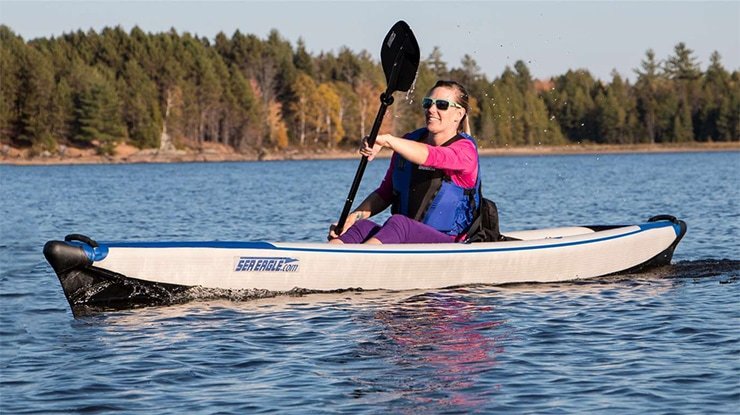
Overall, we were thoroughly impressed with the Sea Eagle RazorLite 393rl inflatable kayak. It’s a high-quality boat that’s durable, agile, and easy to maneuver. The sleek design and sharp bow make it hydrodynamically efficient, helping it glide through the water with ease and pick up speed effortlessly.
Handling on the water is where the RazorLite truly shines. It’s a pleasure to paddle, and we found it to be very responsive to our commands. The stability is excellent, too, even in rough conditions, thanks to the wide beam and low center of gravity.
Comfort-wise, the adjustable seats offer good support and can be customized to fit your body type. The footrests are also adjustable, which is a nice touch that allows you to create a comfortable paddling position. Onboard storage is adequate, with enough room for a day’s worth of supplies, and there are handy bungee cords on the deck to secure items like water bottles and dry bags.
Portability is another strong suit of the RazorLite. It’s easy to inflate and deflate, packing down to a compact size that fits into the included backpack. As for durability, the high-pressure construction is top-notch, which means the RazorLite will stand up to years of use.
All in all, the Sea Eagle RazorLite 393rl is an excellent choice for anyone looking for a high-performance inflatable kayak. It’s built to last, comfortable to paddle, and versatile enough to handle a wide range of water conditions. We highly recommend it!
- Excellent high-speed potential
- Plenty of legroom and support
- Durable against most challenges
- Easy enough to pack down and carry
- Some instability expected due to boat shape
3. Aquaglide Chelan 120 (7.7 / 10)
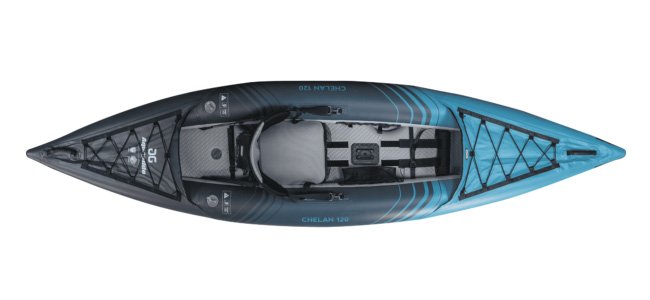
The Aquaglide Chelan 120 is a great inflatable kayak that we thoroughly enjoyed testing. The overall opinion of the kayak is positive due to the variety of features that cater to an enjoyable kayaking experience.
The handling on the water was impressive, and the kayak performed well in calm waters and mild rapids. The stability of the kayak was also impressive, and we felt confident during our kayaking trip.
The comfort of the kayak was also noteworthy, as the seats were comfortable and adjustable. The onboard storage capacity was also impressive, and we were able to pack all the necessary gear for our trip easily. The portability of the kayak made transportation a breeze, and we were able to easily fold and pack the kayak for transport.
Finally, the durability of the kayak was impressive, as it was able to sustain mild scrapes and scratches during our trip without any significant damage.
Overall, we highly recommend the Aquaglide Chelan 120 for anyone looking for an inflatable kayak that performs well, is comfortable, and has ample storage space.
- Super-stable riding, no matter your skill level
- Top-quality build featuring reinforced PVC and drop stitch construction
- Very comfortable over long periods, with the splash guard to keep you dry and inflatable seat cushion for added comfort
- Easy to pack down again and carry
- Highly maneuverable; this kayak turns on a dime!
- Could benefit from more secure storage areas, though the webbing pockets are a nice touch
- The self-bailing scuppers aren’t the best
4. Star Rival (7.5 / 10)
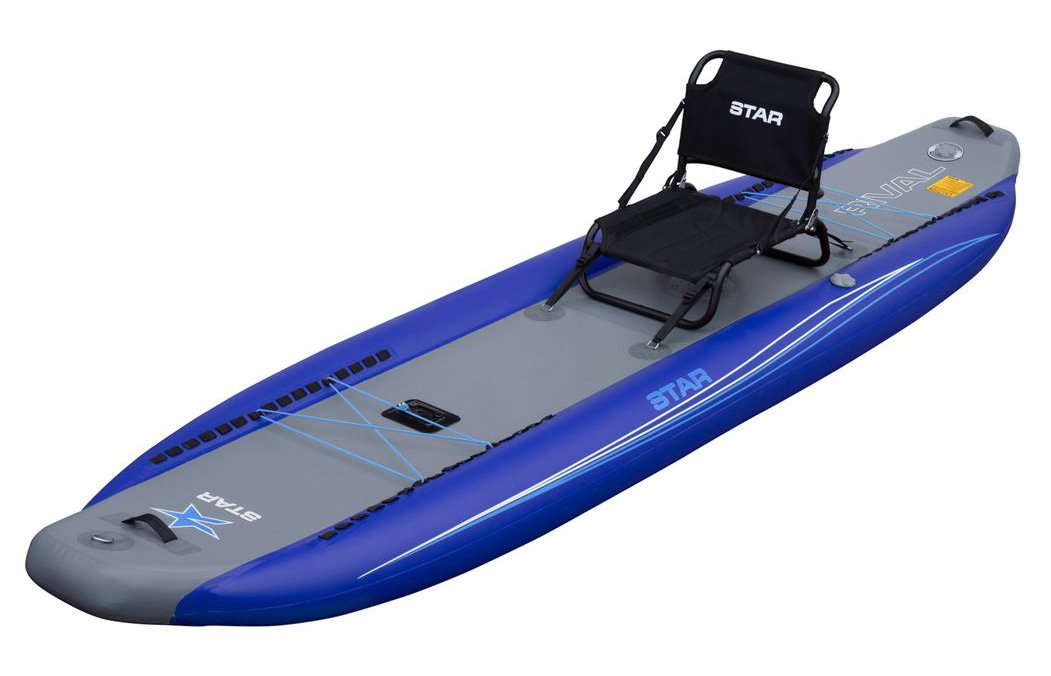
After testing out the Star Rival inflatable kayak, we are thrilled with its performance and overall quality. This kayak is an excellent choice for anyone who loves to paddle on the water.
The handling on the Star Rival was impressive, as it provided a smooth and comfortable ride. The kayak’s sleek design allowed for easy maneuverability, making it especially suitable for beginners or those looking for a stable ride. Speaking of stability, we found that the Star Rival was very stable in calm waters, although it wasn’t ideal for choppier conditions.
One thing we really appreciated about the Star Rival was its comfort. The seats were supportive and adjustable, allowing us to find the perfect position for our paddling needs. Additionally, the onboard storage was ample – we were able to bring all our necessary gear without feeling cramped. When we were done for the day, we found that the kayak was easy to deflate and pack up, making it highly portable.
Finally, we were impressed with the durability of the Star Rival. This kayak is made from high-quality materials that are built to last, and we found that it held up well even during our more vigorous paddling sessions.
Overall, we highly recommend the Star Rival for anyone looking for a high-quality inflatable kayak for personal use. Its excellent handling, stability, comfort, storage and durability make it an excellent choice for both beginners and experienced paddlers alike.
- Highly durable in rough conditions
- Incredible stability
- Nice and easy to turn
- Compacts down well
- Fishing model has tons of mounts for gear
- Not a fast boat by any stretch
- Not great on the legs from a seated position
5. Advanced Elements AirVolution (7.5 / 10)
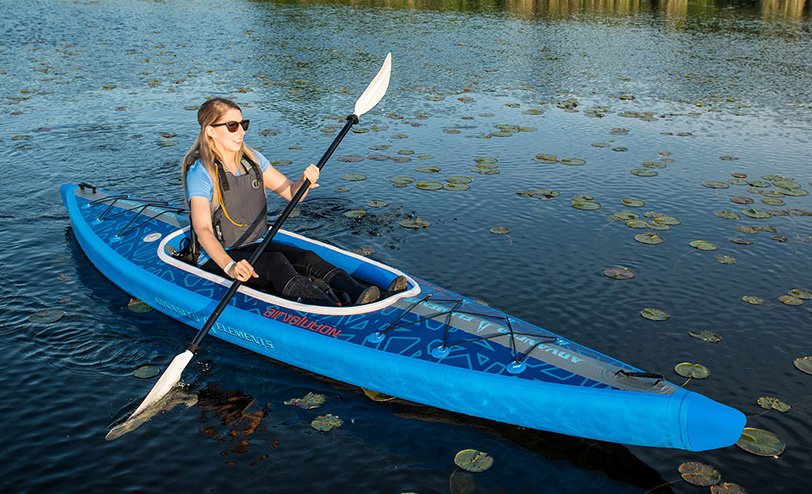
We have tested the Advanced Elements AirVolution kayak and we are impressed with its overall performance. The kayak feels sturdy and is easy to inflate, making it ready to use in no time.
When it comes to handling on the water, the AirVolution is stable and responsive. We found that it tracks well and handles choppy waters with ease. As for stability, we felt secure even in rougher conditions and felt confident in our ability to handle the kayak.
In terms of comfort, the AirVolution is surprisingly spacious and offers great back support. We appreciated the multiple air chambers, which provide added safety and security. As for onboard storage, there is a decent amount of space available for gear and supplies.
Portability is a key factor for inflatable kayaks, and the AirVolution is no exception. It packs down relatively small and is easy to carry, making it a great option for those who enjoy spontaneous paddling trips.
Finally, we found the AirVolution to be both sturdy and durable. The kayak is made from high-quality materials and is designed to withstand the rigours of regular use.
Overall, we would highly recommend the Advanced Elements AirVolution to anyone looking for a reliable, high-performance inflatable kayak.
- Almost hardshell quality performance
- Highly stable and unlikely to tip
- Easy to pack down and carry around
- Highly supportive seating
- Lacks foot pegs for leg support
- Fairly cramped for taller paddlers
- Removable skeg is fairly flimsy
6. Intex Challenger K1 (6.9 / 10)
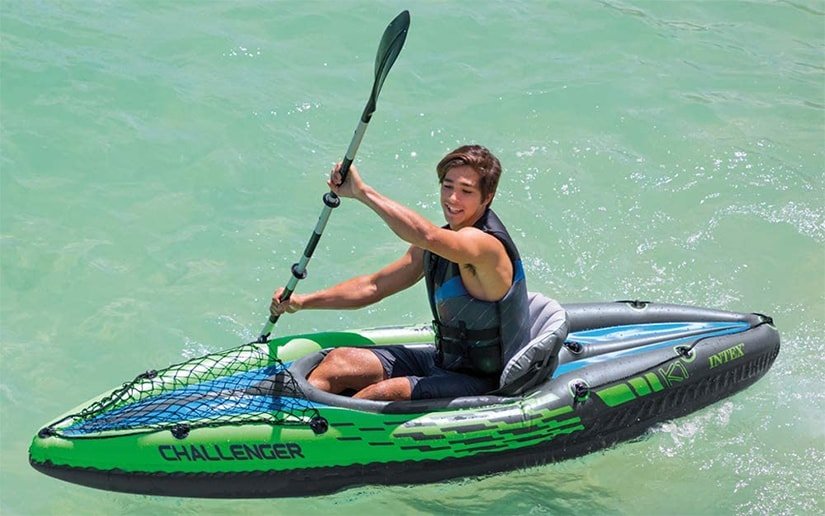
Overall, we were pleasantly surprised by the Intex Challenger K1. Despite its affordable price point, it performed well on the water and held up to our expectations in terms of stability, comfort, and durability.
Handling on the water was smooth and easy with the Challenger K1. We found it to be responsive to our movements, making it a great option for beginner kayakers. Its lightweight design also made it easy to maneuver, even in windy conditions.
Stability was a key factor for us when testing the Challenger K1, and it did not disappoint. Even with choppy water and waves, we felt secure in the kayak. This is a great feature for novice kayakers who may be nervous about tipping.
Comfort was another area where the Challenger K1 exceeded our expectations. The adjustable inflatable seat provided ample support for our backs, making for a comfortable paddling experience, and we appreciated the inclusion of a backrest.
Onboard storage was adequate for a day trip, with a cargo net at the front of the kayak and a waterproof bag for additional items. However, due to its lightweight design, we would not recommend it for extended camping trips where larger amounts of gear are needed.
Portability is always a concern when it comes to inflatable kayaks, but the Challenger K1 was easy to transport and set up. It inflates quickly with the included pump and can be deflated and stored in a compact carrying bag when not in use.
Finally, we were pleasantly surprised by the durability of the Challenger K1. Despite being made of PVC material, it held up well to rocks and rough terrain, and we had no concerns about it puncturing during our testing.
Overall, the Intex Challenger K1 is a great option for novice kayakers or those on a budget. Its performance on the water, stability, and comfort exceeded our expectations, making it a strong contender for our list of recommended inflatable kayaks.
- Amazing portability – very light to carry around
- Nice and easy to paddle in straight lines and on calm water
- Reasonable storage and ease of access
- Thin material and build – won’t fare well on rocky or choppy trips
- Isn’t a very comfortable fit for paddlers over six feet tall
- Only has two air gauges – may be hazardous far away from land
7. Sevylor Quikpak K5 (6.4 / 10)
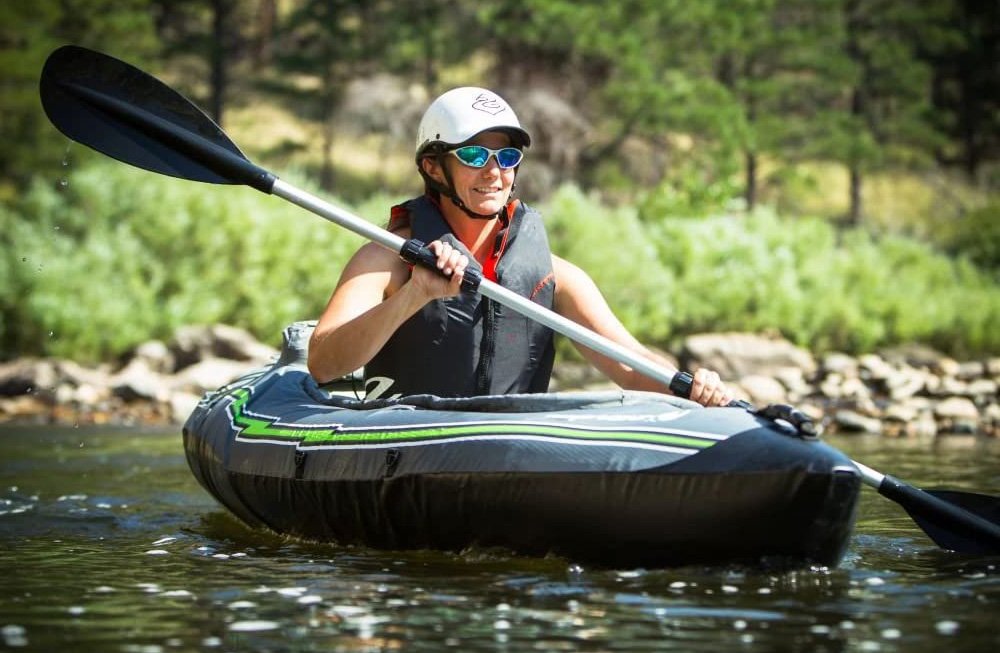
Overall, we were extremely impressed with the Sevylor Quikpak K5 inflatable kayak. As experienced kayak testers, we’ve seen a lot of different models, and this one really stood out to us.
First of all, the handling on the water was excellent. It felt smooth and responsive, and we were able to maneuver around rocks and shallow areas with ease. We were also pleasantly surprised by the stability of the kayak – it felt very stable and secure, even in choppy water.
Comfort-wise, the Sevylor Quikpak K5 did not disappoint either. The adjustable seat was very comfortable, and the backrest provided plenty of support. We also appreciated the onboard storage options – there was ample space for a small cooler, snacks, and other essentials.
Perhaps one of the standout features of this kayak, however, is its portability. The backpack design of the carrying case makes it incredibly easy to transport, even if you’re hiking a fair distance to your put-in spot. And once you’re finished on the water, the kayak packs up quickly and easily, making it a great choice for those who don’t have a ton of storage space at home.
Finally, we were pleased with the overall durability of the Sevylor Quikpak K5. Despite being inflatable, it felt sturdy and well-built, and we had no concerns about its ability to withstand regular use.
All in all, we would highly recommend the Sevylor Quikpak K5 to anyone in the market for an inflatable kayak for one person. It’s versatile, comfortable, and easy to transport – what more could you ask for?
- Innovative backpack design makes it super easy to pack up and move
- Its 24 gauge PVC construction makes it extra-durable
- There’s plenty of legroom and ample storage
- It’s a stable ride for calmer conditions; good for lake use and on calm calm rivers
- The kayak’s thick polyester cover isn’t waterproof – making it tough to dry
- It’s not the easiest kayak for tracking
- Some accessories – like the included paddle – aren’t great quality
How to Find the Best One Person Inflatable Kayak for Your Needs
There’s more to picking the best inflatable solo kayak than simply checking out the price and the availability. You need to take a look at what features the kayak offers, but you also need to consider the type of paddling you’ll be doing.
For example, experienced paddlers who want to take on class iii rapids would need a durable boat, and may consider a whitewater kayak with a drop stitch floor and multiple air chambers.
However, a beginner who is more interested in recreational paddling and the odd kayak camping trip is not going to need something with this level of performance and durability.
Rather, this type of paddler would be better off looking at a lightweight kayak with enough onboard storage to accommodate camping gear, and that packs down easily into a carry bag.
You need to decide on the type of kayaking that interests you the most, and then let that guide your decision as to the best inflatable kayak for your needs.
Inflatable vs Hardshell
You also need to be certain that an inflatable kayak is the best option for you. Hardshell kayaks are still a popular choice among many people. When choosing a kayak, one of the most important decisions you’ll make is whether to go with a hard shell or an inflatable model.
Hard Shells are Popular With Experienced Paddlers
Hard shell kayaks are made from tough materials like polyethylene and fiberglass, which makes them very durable and long-lasting. They’re excellent for maneuverability and speed, making them a popular choice with more experienced paddlers.
Many inflatable kayaks are still durable, though, standing up to bumps and scrapes without any damage (though if you opt for a suspiciously cheap kayak then this may not be the case).
Hardshell kayaks are better designed for touring and whitewater conditions, but some recreational inflatable kayaks have been known to handle class iii rapids competently.
However, if you want to tackle serious conditions like class iv whitewater rapids, then you’ll either need a hard shell, or an inflatable that has been specifically designed to be up to the task.
Hard Shell Kayaks Are Harder to Store
While hard shell kayaks are more performance-oriented, the fact that they are solid means they’re more difficult to transport due to their size and weight, and they require more storage space than inflatable kayaks.
Inflatable kayaks, on the other hand, are lightweight and compact, making them a great choice for those with limited space – in most cases, you can fit the entire kayak in a carry case and then stash it under your bed or in a closet.
Inflatable Kayaks are More Affordable
Inflatable kayaks are also generally more affordable than hard shell kayaks, and they’re easier to transport – you can travel with an inflatable kayak in the trunk of your car, for instance.
Inflatable kayaks also do not suffer in terms of performance – they’re still good enough for most paddlers, even if they’re not as finely-tuned as hard shells (they can pretty much hold their own against their solid counterparts). Most decent models feature drop stitch floor for extra rigidity, making them just as stable.
Generally, a hardshell kayak is going to be more suited to touring and whitewater conditions. The choice between a hard shell kayak or an inflatable kayak ultimately depends on your particular needs: portability vs performance.
There Are Different Types of Inflatable Kayaks (According to Capacity)
There are different types of inflatable kayak, and while most of them can be paddled by a single person, they aren’t always marketed as such. Most traditional kayaks (whether inflatable or hardshell) can comfortably hold one person.
However, if you’re dealing with a larger kayak with ample on board storage space, then this could conceivably hold more than one person.
It’s safe to assume, though, that most inflatable kayaks (or kayaks in general) are single person kayaks, unless they are expressly described as otherwise.
Solo Inflatable Kayaks
While a quality inflatable kayak of a large enough size may be able to accommodate more than one passenger, this isn’t really recommended. As stated, it’s safe to assume that the standard for kayaks is a single person vessel.
If the kayak is suitable for anything other than solo paddlers, then this will usually be expressly mentioned in the kayak name, category or and description.
So, while you may not see the moniker ‘solo kayak’ being thrown around all that often, don’t assume that means a given kayak is not suitable for solo paddlers.
A multi person kayak will likely have a name to indicate this; other inflatable kayaks may have names like ‘family kayak’, ‘tandem kayak,’ or even ‘multi person kayak’.
For the sake of simplicity, it might be best to assume that every inflatable kayak is a one person inflatable kayak, unless told otherwise.
Tandem Inflatable Kayaks
A tandem inflatable kayak is exactly what it sounds like – a kayak that you can ride in tandem with someone else (i.e. a two person inflatable kayak), so they tend to be larger than single person kayaks.
Tandem inflatable kayaks are popular among smaller families, couples, or friends who want to enjoy kayaking together in lakes, slow-moving rivers, or calm ocean waters (as such, they are most often suited to recreational paddling and flatwater touring, rather than rougher conditions).
So when would you choose a tandem inflatable kayak over a solo inflatable kayak? The answer comes down, once again, to the type of paddling you intend to do. If you’re perfectly happy being a solo passenger, then a one person inflatable kayak is fine.
If you want to have the option of taking an extra person out with you, then a tandem inflatable kayak could be the better option. It’s easier to paddle a tandem inflatable kayak alone than it is to add an extra passenger to a solo inflatable kayak.
Family Inflatable Kayaks
Most inflatable kayaks are designed to hold one or two people, but there are larger options if you want to take multiple passengers out on the water. A family kayak is one such vessel – it’s a type of kayak that is designed to accommodate several people, usually two adults and one or two children.
These kayaks feature multiple seats or seating spaces, often with features to help with configuration (to assist with accommodating multiple passengers). These could be anything from a removable or adjustable seat to adjustable foot braces, backrests and footrests for comfort during longer paddling trips.
Family kayaks are often wider and more stable than traditional kayaks to provide a safe and comfortable experience for children who may be new to kayaking. They are typically wider than single or tandem kayaks, and they often have ample storage space for gear and snacks.
Family kayaks are perfect for parents who want to share their love of kayaking with their children or for families and groups of friends who want to enjoy a fun and exciting outdoor activity together.
Sit Inside Vs Sit On Top: Which is A Better Choice for a Solo Inflatable Kayak?
So, now that you’re sure that a single person inflatable kayak (rather than other types of inflatable kayaks) is right for you, you need to consider whether you want a sit inside, or a sit on top (SOT).
SOT Inflatable Kayaks
Sit-on-top kayaks are exactly what they sound like. A kayak that you sit on top of (rather than inside). They are designed with an ‘open’ deck and are equipped with seats that are set flush with the kayak’s top.
Sit on top kayaks are easier to get in and out of than other types of kayak, making them a great choice for beginners or those who want to get out to swim or snorkel. Add a couple of rod holders and they make a great fishing vessel too!
Sit-Inside Inflatable Kayaks
Sit-inside kayaks feature a cockpit that the paddler sits in, with their legs and lower body enclosed within the kayak’s body. This design provides additional protection from the cold and water splashes, making them a popular choice for use in colder or rougher waters.
With the addition of a spray skirt, they can offer quite a lot of protection from getting too wet or cold during your kayaking ventures – so if you live somewhere with inclement weather, a sit-inside might be the better choice when looking for the best inflatable kayak for your needs.
Other Things to Consider When Shopping for in a Single Inflatable Kayak
The best inflatable kayaks will have common features to watch out for (such as a drop stitch floor and a paddle holder), which should help to narrow down your search for one that best suits your needs.
All of the kayaks we’ve included in this list are worthy of consideration, but you should still pay attention to how each kayak fairs according to certain criteria:
Kayak Size
Consider the size of the kayak- length, width, and weight. Longer, slimmer kayaks are typically faster and more efficient, while wider kayaks provide more stability.
If you’re a beginner, you may want to choose a wider kayak to help ensure a stable ride, whereas intermediate or advanced paddlers might favor better performance over enhanced stability.
Choosing the right kayak size for your weight is crucial if you want a comfortable ride. The appropriate size will differ depending on whether it’s an inflatable or not, so be sure to check the specifications of the kayak before purchasing.
Material and Build
Inflatable kayaks should be built from sturdy material, with particular attention given to ensuring that the kayak is both rigid and hard wearing. This means features like a drop stitch floor and a decent max inflation PSI for rigidity are good to look out for.
Having multiple air chambers is also a plus, because it means you don’t have to worry about sinking if you get a puncture.
Other things to look out for can include extra features in accordance with the type of kayak (such as a spray skirt for a sit inside) or optional extras such as rod holders, or bungee storage at the bow and stern.
Onboard Storage
If you plan on kayaking for an extended period, storage space is crucial. Look for kayaks that have plenty of space for your gear or snacks. Kayaks may also have different rigging, such as bungees or straps at the bow and stern to secure your gear or paddle.
Comfort
You obviously won’t know how comfortable a kayak is until you take it out on the water, but checking out what other paddlers have to say can give a good indication. Plus, certain features and accessories can indicate how comfortable the kayak might be.
Comfort features might include things like an adjustable seat, footrests, and backrest; these should be comfortable enough for longer kayaking trips.
Handling and Maneuverability
This seems like an obvious thing to check, but you need to pay attention to how the kayak actually performs on the water. Is it stable or tippy? How easy is it to make quick, sharp turns? Is it easy for one person to paddle or not?
Check the kayak’s maneuverability, especially if you plan to navigate through a more challenging waterway.
Type of Kayak
And finally, there are different types of kayaks to consider, such as recreational kayaks, touring kayaks, and sea kayaks.
Choose a type of kayak that best suits the type of water you’ll be kayaking in – though be aware that inflatable kayaks generally do not compare to hard shells when it comes to serious touring or whitewater kayaking.
Recreational Kayaks
These kayaks are designed for calm and flat water conditions, such as a lake or pond. They are typically a happy medium – wide and stable enough, and ideal for beginners.
Touring Kayaks
These kayaks are designed for longer distances and open water conditions, such as a river or calm ocean. They are longer and narrower, designed for greater speed and efficiency.
Whitewater Kayaks
These kayaks are designed for navigating through rapids and fast-moving water. They have short hulls and a rounded rocker profile, allowing for greater maneuverability and quick turns.
Ocean Kayaks
These kayaks are designed for use in the ocean and other open water conditions. They have a long, narrow hull, similar to touring kayaks, with features that allow for better handling in surf and currents.
Fishing Kayaks
These kayaks are specifically designed for fishing, with features such as rod holders, storage compartments, and stability. Often SOT kayaks, they can be used in a variety of water conditions, from calm to open ocean.
Best Inflatable Kayaks for a Single Person: FAQ
What’s the difference between an inflatable kayak and a single person inflatable kayak?
Generally speaking, an inflatable kayak and a single person inflatable kayak are the same thing. Most kayaks are designed to carry a single passenger (unless stated otherwise, such as with a tandem kayak).
Are single or two person inflatable kayaks better?
This depends on a number of factors. Even the best solo inflatable kayaks may be inferior to a tandem for someone who wants to take another passenger on board, or for someone who needs onboard storage for camping gear or other kit and accessories.
However, for those who are merely interested in solo paddling, a two person inflatable kayak is not necessary. It all depends on the individual’s needs.
What is single vs double kayaking?
Single kayaking refers to kayaking solo in a kayak designed for one person. The paddler sits in the kayak’s cockpit and uses a single paddle to steer and propel themselves forward. Single kayaks are smaller than tandems, and are lighter and easier for a single paddler to maneuver.
Double kayaking, on the other hand, involves two people sitting one behind the other in a kayak built for two. Depending on the specific model, some double kayaks may be designed to convert into a single kayak if only one person is paddling, providing additional flexibility (and more legroom for tall paddlers too).
Is paddling a single inflatable kayak hard?
Single kayaking can be challenging, but kayaking in and of itself is an accessible sport without a steep learning curve. Paddling a single inflatable kayak alone is not especially hard – it’s what they’re designed for!
It’s actually more difficult to paddle a multi-person kayak alone, especially for beginners who are unfamiliar with the equipment or may not have the upper body strength and paddling technique necessary to maneuver the kayak effectively.
What size single person inflatable kayak is right for my height and weight?
General guidelines for inflatable kayak sizes based on the paddlers height and weight are as follows:
- Paddlers under 5 feet: Choose an 8 foot kayak
- Paddlers between 5 feet and 5’6: Choose an 8 – 10 foot kayak
- Paddlers between 5’7 and 6 feet: Choose a 10 – 12 foot kayak
- Paddlers over 6 feet: Choose a 12 foot kayak or larger

